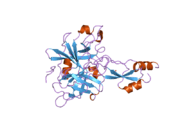References
- 1 2 3 GRCh38: Ensembl release 89: ENSG00000109758 - Ensembl, May 2017
- 1 2 3 GRCm38: Ensembl release 89: ENSMUSG00000029102 - Ensembl, May 2017
- ↑ "Human PubMed Reference:".
- ↑ "Mouse PubMed Reference:".
- ↑ Miyazawa K, Shimomura T, Kitamura A, Kondo J, Morimoto Y, Kitamura N (Jun 1993). "Molecular Cloning and Sequence Analysis of the cDNA for a Human Serine Protease Responsible for Activation of Hepatocyte Growth Factor. Structural similarity of the protease precursor to blood coagulation factor XII". J Biol Chem. 268 (14): 10024–8. PMID 7683665.
- ↑ Shimomura T, Kondo J, Ochiai M, Naka D, Miyazawa K, Morimoto Y, Kitamura N (Dec 1993). "Activation of the zymogen of hepatocyte growth factor activator by thrombin". J Biol Chem. 268 (30): 22927–32. PMID 8226803.
- 1 2 "Entrez Gene: HGFAC HGF activator".
Further reading
- Nakamura T (1992). "Structure and function of hepatocyte growth factor". Prog. Growth Factor Res. 3 (1): 67–85. doi:10.1016/0955-2235(91)90014-U. PMID 1838014.
- Shimomura T, Ochiai M, Kondo J, Morimoto Y (1992). "A novel protease obtained from FBS-containing culture supernatant, that processes single chain form hepatocyte growth factor to two chain form in serum-free culture". Cytotechnology. 8 (3): 219–29. doi:10.1007/BF02522039. PMID 1368819.
- Miyazawa K, Shimomura T, Kitamura N (1996). "Activation of hepatocyte growth factor in the injured tissues is mediated by hepatocyte growth factor activator". J. Biol. Chem. 271 (7): 3615–8. doi:10.1074/jbc.271.7.3615. PMID 8631970.
- Shimomura T, Denda K, Kitamura A, et al. (1997). "Hepatocyte growth factor activator inhibitor, a novel Kunitz-type serine protease inhibitor". J. Biol. Chem. 272 (10): 6370–6. doi:10.1074/jbc.272.10.6370. PMID 9045658.
- Kawaguchi T, Qin L, Shimomura T, et al. (1997). "Purification and cloning of hepatocyte growth factor activator inhibitor type 2, a Kunitz-type serine protease inhibitor". J. Biol. Chem. 272 (44): 27558–64. doi:10.1074/jbc.272.44.27558. PMID 9346890.
- Miyazawa K, Wang Y, Minoshima S, et al. (1999). "Structural organization and chromosomal localization of the human hepatocyte growth factor activator gene--phylogenetic and functional relationship with blood coagulation factor XII, urokinase, and tissue-type plasminogen activator". Eur. J. Biochem. 258 (2): 355–61. doi:10.1046/j.1432-1327.1998.2580355.x. PMID 9874200.
- Kataoka H, Shimomura T, Kawaguchi T, et al. (2001). "Hepatocyte growth factor activator inhibitor type 1 is a specific cell surface binding protein of hepatocyte growth factor activator (HGFA) and regulates HGFA activity in the pericellular microenvironment". J. Biol. Chem. 275 (51): 40453–62. doi:10.1074/jbc.M006412200. PMID 11013244.
- Kataoka H, Meng JY, Itoh H, et al. (2001). "Localization of hepatocyte growth factor activator inhibitor type 1 in Langhans' cells of human placenta". Histochem. Cell Biol. 114 (6): 469–75. doi:10.1007/s004180000228. PMID 11201608.
- Strausberg RL, Feingold EA, Grouse LH, et al. (2003). "Generation and initial analysis of more than 15,000 full-length human and mouse cDNA sequences". Proc. Natl. Acad. Sci. U.S.A. 99 (26): 16899–903. doi:10.1073/pnas.242603899. PMC 139241. PMID 12477932.
- Anderson NL, Polanski M, Pieper R, et al. (2004). "The human plasma proteome: a nonredundant list developed by combination of four separate sources". Mol. Cell. Proteomics. 3 (4): 311–26. doi:10.1074/mcp.M300127-MCP200. PMID 14718574.
- Tjin EP, Derksen PW, Kataoka H, et al. (2004). "Multiple myeloma cells catalyze hepatocyte growth factor (HGF) activation by secreting the serine protease HGF-activator". Blood. 104 (7): 2172–5. doi:10.1182/blood-2003-12-4386. PMID 15172968.
- Zhang Z, Henzel WJ (2005). "Signal peptide prediction based on analysis of experimentally verified cleavage sites". Protein Sci. 13 (10): 2819–24. doi:10.1110/ps.04682504. PMC 2286551. PMID 15340161.
- Shia S, Stamos J, Kirchhofer D, et al. (2005). "Conformational lability in serine protease active sites: structures of hepatocyte growth factor activator (HGFA) alone and with the inhibitory domain from HGFA inhibitor-1B". J. Mol. Biol. 346 (5): 1335–49. doi:10.1016/j.jmb.2004.12.048. PMID 15713485.
- Tjin EP, Groen RW, Vogelzang I, et al. (2006). "Functional analysis of HGF/MET signaling and aberrant HGF-activator expression in diffuse large B-cell lymphoma". Blood. 107 (2): 760–8. doi:10.1182/blood-2005-05-1929. PMID 16189274.
- Liu T, Qian WJ, Gritsenko MA, et al. (2006). "Human plasma N-glycoproteome analysis by immunoaffinity subtraction, hydrazide chemistry, and mass spectrometry". J. Proteome Res. 4 (6): 2070–80. doi:10.1021/pr0502065. PMC 1850943. PMID 16335952.
PDB gallery |
|---|
1ybw: Protease domain of HGFA with no inhibitor 1yc0: short form HGFA with first Kunitz domain from HAI-1 |







